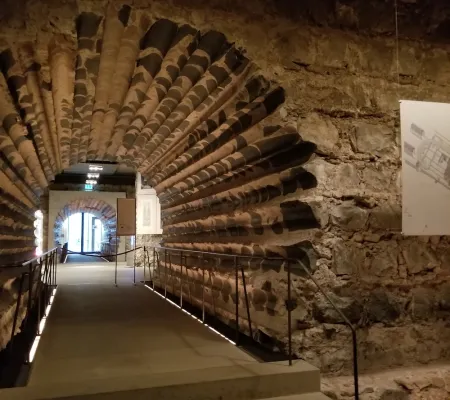There will always be something special and vital about viewing art and architecture in person. For art historians, traveling to sites and visiting museums is both stimulating and critical to their research. In October, UT Art History professors Joan Holladay and Jeffrey Chipps Smith traveled with their graduate seminar, Cologne and Nuremberg: A Tale of Two Cities, to Cologne and Nuremberg, Germany; to allow graduate students close study with the original the works they’ve grown to know through assigned readings and class discussions.
The course capitalizes on Holladay and Smith’s respective research strengths, contrasting medieval Cologne and early modern Nuremberg as two cities with fascinating yet quite distinctive developmental histories tied to their geographic locations and foundational narratives. Where Cologne boasts its ancient Roman origins and early Christian heritage, a city of saints and majestic churches under the aegis of a powerful archbishop; Nuremberg, a millennium younger, is a town of wealthy merchants and precision artisans. In Nuremberg, the city government, not the Catholic Church, controlled its institutions and shaped its character. Holladay and Smith’s seminar examines the art and architecture of Cologne and Nuremberg as a means of understanding the cities’ respective cultural and religious legacies.
The trip to Cologne and Nuremberg, funded by the Kimbell Art Foundation, functioned as a capstone to the seminar. For doctoral candidate Christopher Wood, the trip to Germany was the second such seminar trip he had attended in his graduate career. The first was to the city of Rome in 2015 with Holladay and Art History Professor Penelope Davies. “For me the experience of traveling to Cologne and Nuremberg provides a unique opportunity to not only study two Medieval cities in context, but also as point and counterpoint to two different historical trajectories,” writes Wood. “This trip will not only afford us the opportunity to network with international scholars and curators, but also to study these unique architectural spaces in a modern context, which really highlights these locations as truly ‘living cities’.”
My research interests are focused primarily on the Roman architecture, but I am also interested in the Medieval reception of the Classical world. Specifically, I’m interested in how the continuity of the past is preserved through the language of architecture, how spaces and materials are reused and what this communicates in terms of identity. A great example: many Christian churches are built over the remains of pagan temples. This communicates not just an economic impetus, re-use of available foundations and materials, but also a narrative of theological supremacy.
As a master’s student in this program, I traveled with Dr. Holladay and Dr. Davies as part of a course on the art and politics of Pre-modern Rome. It was an incredible, once in a lifetime experience that none of us will soon forget and it inspired many students to pursue viable areas of research. It is one thing to study architecture and visual narratives from a book, and quite another to study it in context, especially while navigating the busy streets of a modern European city.
Fellow doctoral candidate Arianna Ray echoed Woods’ excitement to study work in context, writing, “Although I have been involved in art history for many years now, I have never had the opportunity to view and discuss works of art in situ with others who study and appreciate art the same as I do.”
“Anyone who studies art knows that looking at an image can never compare to looking at a work in person and seeing it the way it was meant to be seen,” Ray explains. “I expect, of course, to be challenged, to be exhausted at the end of the day, and to be overloaded with information. But I also expect for this to be a thrilling and unique educational experience that changes my perspective on the course material and spurs new discussions and research.”
With all of the anticipation surrounding the trip, we asked these graduate students to send us back some of their responses from the field. The following is an account of their trip from a variety of voices and experiences, detailing travels to the Römisch-Germanisches Museum and Albert Dürer’s House, the sarcophagus of Count Emundus and the zigzag palimpsest of bones adorning the walls of the Golden Room within St. Ursula in Cologne.
Alexis Slater: Arrival in Cologne and Römisch-Germanisches Museum
Catherine Powell: Wallraf-Richardz Museum
Christopher Wood: Cologne Cathedral, the Praetorium, and St. Ursula
Arianna Ray: Germanisches Naitonalmuseum, the St. Klara church, and the Lorenzkirche
To view all of the images from their trip, please visit the UT Department of Art and Art History Flickr page.


